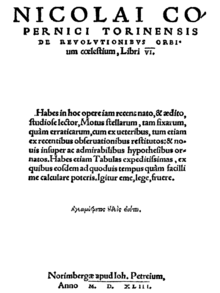De Revolutionibus

Original 1543 Nuremberg edition
|
|
| Author | Nicolaus Copernicus |
|---|---|
| Language | Latin |
| Subject | Astronomy |
| Publisher |
Johannes Petreius (Nuremberg) |
|
Publication date
|
1543 |
| Pages | 405 |
De revolutionibus orbium coelestium (On the Revolutions of the Heavenly Spheres) is the seminal work on the heliocentric theory of the Renaissance astronomer Nicolaus Copernicus (1473–1543). The book, first printed in 1543 in Nuremberg, Holy Roman Empire, offered an alternative model of the universe to Ptolemy's geocentric system, which had been widely accepted since ancient times.
Copernicus initially outlined his system in a short, untitled, anonymous manuscript that he distributed to several friends, referred to as the Commentariolus. A physician's library list dating to 1514 includes a manuscript whose description matches the Commentariolus, so Copernicus must have begun work on his new system by that time. Most historians believe that he wrote the Commentariolus after his return from Italy, possibly only after 1510. At this time, Copernicus anticipated that he could reconcile the motion of the Earth with the perceived motions of the planets easily, with fewer motions than were necessary in the Alfonsine Tables, the version of the Ptolemaic system current at the time. In particular, the heliocentric Copernican model made use of the Urdi Lemma developed in the 13th century by Mu'ayyad al-Din al-'Urdi, the first of the Maragha astronomers to develop a non-Ptolemaic model of planetary motion.
Observations of Mercury by Bernhard Walther (1430–1504) of Nuremberg, a pupil of Regiomontanus, were made available to Copernicus by Johannes Schöner, 45 observations in total, 14 of them with longitude and latitude. Copernicus used three of them in De revolutionibus, giving only longitudes, and erroneously attributing them to Schöner. Copernicus' values differed slightly from the ones published by Schöner in 1544 in Observationes XXX annorum a I. Regiomontano et B. Walthero Norimbergae habitae, [4°, Norimb. 1544].
...
Wikipedia
